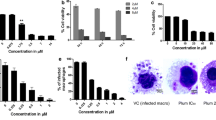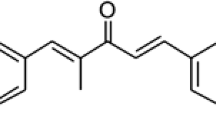Abstract
Curcumin, a polyphenol compound, has been recognized as a promising anti-cancer drug. The purpose of the present study was to investigate the cytotoxicity of curcumin to Leishmania donovani, the causative agent for visceral leishmaniasis. Flow cytometric analysis revealed that curcumin induced cell cycle arrest at G2/M phase. Incubation of Leishmania promastigotes with curcumin caused exposure of phosphatidylserine to the outer leaflet of plasma membrane. This event is preceded by curcumin-induced formation of reactive oxygen species (ROS) and elevation of cytosolic calcium through the release of calcium ions from intracellular stores as well as by influx of extracellular calcium. Elevation of cytosolic calcium is responsible for depolarization of mitochondrial membrane potential (ΔΨm), release of Cytochrome c into the cytosol and concomitant nuclear alterations that included deoxynucleotidyltransferase-mediated dUTP end labeling (TUNEL) and DNA fragmentation. Taken together, these data indicate that curcumin has promising antileishmanial activity that is mediated by programmed cell death and, accordingly, merits further investigation as a therapeutic option for the treatment of leishmaniasis.











Similar content being viewed by others
Abbreviations
- SR:
-
Sarcoplasmic reticulum
- ROS:
-
Reactive oxygen species
- PI:
-
Propidium iodide
- NAC:
-
N-acetyl-cysteine
- DMSO:
-
dimethyl sulfoxide
- TUNEL:
-
Terminal deoxynucleotidyltransferase enzyme-mediated dUTP end labeling
- HU:
-
Hydroxyurea
References
Iwu MM, Jackson JE, Schuster BG (1994) Medicinal plants in the fight against leishmaniasis. Parasitol Today 10:65–68. doi:10.1016/0169-4758(94)90398-0
Kayser O, Kiderlen AF, Croft SL (2003) Natural products as antiparasitic drugs. Parasitol Res 90:S55–S62. doi:10.1007/s00436-002-0768-3
Sharma RA, Gescher AJ, Steward WP (2005) Curcumin: the story so far. Eur J Cancer 41:1955–1968. doi:10.1016/j.ejca.2005.05.009
Mukherjee Nee Chakraborty S, Ghosh U, Bhattacharyya NP, Bhattacharya RK, Dey S, Roy M (2007) Curcumin-induced apoptosis in human leukemia cell HL-60 is associated with inhibition of telomerase activity. Mol Cell Biochem 297:31–39. doi:10.1007/s11010-006-9319-z
Fang J, Lu J, Holmgren A (2005) Thioredoxin reductase is irreversibly modified by curcumin: a novel molecular mechanism for its anticancer activity. J Biol Chem 280:25284–25290. doi:10.1074/jbc.M414645200
Su CC, Chen GW, Lin JG, Wu LT, Chung JG (2006) Curcumin inhibits cell migration of human colon cancer colo 205 cells through the inhibition of nuclear factor kappa B/p65 and down-regulates cyclooxygenase-2 and matrix metalloproteinase-2 expressions. Anticancer Res 26:1281–1288
Reddy AC, Lokesh BR (1994) Effect of dietary turmeric (Curcuma longa) on iron-induced lipid peroxidation in the rat liver. Food Chem Toxicol 32:279–283. doi:10.1016/0278-6915(94)90201-1
Nagabhushan M, Amonkar AJ, Bhide SV (1987) In vitro antimutagenicity of curcumin against environmental mutagens. Food Chem Toxicol 25:545–547. doi:10.1016/0278-6915(87)90207-9
Mazumder A, Raghavan K, Weinstein J, Kohn KW, Pommier Y (1995) Inhibition of human immunodeficiency virus type-1 integrase by curcumin. Biochem Pharmacol 49:1165–1170. doi:10.1016/0006-2952(95)98514-A
Joe B, Vijaykumar M, Lokesh BR (2004) Biological properties of curcumin-cellular and molecular mechanisms of action. Crit Rev Food Sci Nutr 44:97–111. doi:10.1080/10408690490424702
Cui SX, Qu XJ, Xie YY, Zhou L, Nakata M, Makuuchi M et al (2006) Curcumin inhibits telomerase activity in human cancer cell lines. Int J Mol Med 18:227–231
Liao YF, Hung HC, Hour TC, Hsu PC, Kao MC, Tsay GJ et al (2008) Curcumin induces apoptosis through an ornithine decarboxylase-dependent pathway in human promyelocytic leukemia HL-60 cells. Life Sci 82:367–375
Nose M, Koide T, Ogihara Y, Yabu Y, Ohta N (1998) Trypanocidal effects of curcumin in vitro. Biol Pharm Bull 21:643–645
Pérez-Arriaga L, Mendoza-Magaña ML, Cortés-Zárate R, Corona-Rivera A, Bobadilla-Morales L, Troyo-Sanromán R et al (2006) Cytotoxic effect of curcumin on Giardia lamblia trophozoites. Acta Trop 98:152–161. doi:10.1016/j.actatropica.2006.03.005
Rasmussen HB, Christensen SB, Kvist LP, Karazmi A (2000) A simple and efficient separation of the curcumins, the antiprotozoal constituents of Curcuma longa. Planta Med 66:396–398. doi:10.1055/s-2000-8533
Reddy RC, Vatsala PG, Keshamouni VG, Padmanaban G, Rangarajan PN (2005) Curcumin for malaria therapy. Biochem Biophys Res Commun 326:472–474. doi:10.1016/j.bbrc.2004.11.051
Nandakumar DN, Nagaraj VA, Vathsala PG, Rangarajan P, Padmanaban G (2006) Curcumin-artemisinin combination therapy for malaria. Antimicrob Agents Chemother 50:1859–1860. doi:10.1128/AAC.50.5.1859-1860.2006
Cui L, Miao J, Cui L (2007) Cytotoxic effect of curcumin on malaria parasite Plasmodium falciparum: inhibition of histone acetylation and generation of reactive oxygen species. Antimicrob Agents Chemother 51:488–494. doi:10.1128/AAC.01238-06
Lee N, Bertholet S, Debrabant A, Muller J, Duncan R, Nakhasi HL (2002) Programmed cell death in the unicellular protozoan parasite Leishmania. Cell Death Differ 9:53–64. doi:10.1038/sj.cdd.4400952
Sen N, Das BB, Ganguly A, Mukherjee T, Tripathi G, Bandyopadhyay S et al (2004) Camptothecin induced mitochondrial dysfunction leading to programmed cell death in unicellular hemoflagellate Leishmania donovani. Cell Death Differ 11:924–936. doi:10.1038/sj.cdd.4401435
Das M, Mukherjee SB, Shaha C (2001) Hydrogen peroxide induces apoptosis-like death in Leishmania donovani promastigotes. J Cell Sci 114:2461–2469
Zangger H, Mottram JC, Fasel N (2002) Cell death in Leishmania induced by stress and differentiation: programmed cell death or necrosis? Cell Death Differ 9:1126–1139. doi:10.1038/sj.cdd.4401071
Debrabant A, Lee N, Bertholet S, Duncan R, Nakhasi HL (2003) Programmed cell death in trypanosomatids and other unicellular organisms. Int J Parasitol 33:257–267. doi:10.1016/S0020-7519(03)00008-0
Saleheen D, Ali SA, Ashfaq K, Siddiqui AA, Agha A, Yasinzai MM (2002) Latent activity of curcumin against leishmaniasis in vitro. Biol Pharm Bull 25:386–389. doi:10.1248/bpb.25.386
Le Bras M, Clément MV, Pervaiz S, Brenner C (2005) Reactive oxygen species and the mitochondrial signaling pathway of cell death. Histol Histopathol 20:205–219
Soto M, Iborra S, Quijada L, Folgueira C, Alonso C, Requena JM (2004) Cell-cycle-dependent translation of histone mRNAs is the key control point for regulation of histone biosynthesis in Leishmania infantum. Biochem J 379:617–625. doi:10.1042/BJ20031522
Mukherjee SB, Das M, Sudhandiran G, Shaha C (2002) Increase in cytosolic Ca2+ levels through the activation of non-selective cation channels induced by oxidative stress causes mitochondrial depolarization leading to apoptosis-like death in Leishmania donovani promastigotes. J Biol Chem 277:24717–24727. doi:10.1074/jbc.M201961200
Kunwar A, Barik A, Mishra B, Rathinasamy K, Pandey R, Priyadarsini KI (2008) Quantitative cellular uptake, localization and cytotoxicity of curcumin in normal and tumor cells. Biochim Biophys Acta 1780:673–679
Mehta A, Shaha C (2004) Apoptotic death in Leishmania donovani promastigotes in response to respiratory chain inhibition: complex II inhibition results in increased pentamidine cytotoxicity. J Biol Chem 279:11798–11813. doi:10.1074/jbc.M309341200
Compton MM (1992) A biochemical hallmark of apoptosis: internucleosomal degradation of the genome. Cancer Metastasis Rev 11:105–119. doi:10.1007/BF00048058
Wan CP, Myung E, Lau BH (1993) An automated micro-fluorometric assay for monitoring oxidative burst activity of phagocytes. J Immunol Methods 159:131–138. doi:10.1016/0022-1759(93)90150-6
Bhaumik S, Anjum R, Rangaraj N, Pardhasaradhi BV, Khar A (1999) Curcumin mediated apoptosis in AK-5 tumor cells involves the production of reactive oxygen intermediates. FEBS Lett 456:311–314. doi:10.1016/S0014-5793(99)00969-2
Jana NR, Dikshit P, Goswami A, Nukina N (2004) Inhibition of proteasomal function by curcumin induces apoptosis through mitochondrial pathway. J Biol Chem 279:11680–11685. doi:10.1074/jbc.M310369200
Duchen MR (2000) Mitochondria and calcium: from cell signalling to cell death. J Physiol 529:57–68. doi:10.1111/j.1469-7793.2000.00057.x
Sen N, Das BB, Ganguly A, Mukherjee T, Bandyopadhyay S, Majumder HK (2004) Camptothecin-induced imbalance in intracellular cation homeostasis regulates programmed cell death in unicellular hemoflagellate Leishmania donovani. J Biol Chem 279:52366–52375. doi:10.1074/jbc.M406705200
Koya RC, Fujita H, Shimizu S, Ohtsu M, Takimoto M, Tsujimoto Y et al (2000) Gelsolin inhibits apoptosis by blocking mitochondrial membrane potential loss and cytochrome c release. J Biol Chem 275:15343–15349. doi:10.1074/jbc.275.20.15343
Scheffler IE (1999) Mitochondria. Wiley-Liss, New York
Rittig MG, Bogdan C (2000) Leishmania-host-cell interaction: complexities and alternative views. Parasitol Today 16:292–297. doi:10.1016/S0169-4758(00)01692-6
Park C, Kim GY, Kim GD, Choi BT, Park YM, Choi YH (2006) Induction of G2/M arrest and inhibition of cyclooxygenase-2 activity by curcumin in human bladder cancer T24 cells. Oncol Rep 15:1225–1231
Chipuk JE, Green DR (2005) Do inducers of apoptosis trigger caspase-independent cell death? Nat Rev Mol Cell Biol 6:268–275. doi:10.1038/nrm1573
Ahsan H, Parveen N, Khan NU, Hadi SM (1999) Pro-oxidant, anti-oxidant and cleavage activities on DNA of curcumin and its derivatives demethoxycurcumin and bisdemethoxycurcumin. Chem Biol Interact 121:161–175. doi:10.1016/S0009-2797(99)00096-4
Litwinienko G, Ingold KU (2004) Abnormal solvent effects on hydrogen atom abstraction. 2. Resolution of the curcumin antioxidant controversy. The role of sequential proton loss electron transfer. J Org Chem 69:5888–5896. doi:10.1021/jo049254j
Chan MM, Adapala NS, Fong D (2005) Curcumin overcomes the inhibitory effect of nitric oxide on Leishmania. Parasitol Res 96:49–56. doi:10.1007/s00436-005-1323-9
Galati G, Sabzevari O, Wilson JX, O’Brien PJ (2002) Prooxidant activity and cellular effects of the phenoxyl radicals of dietary flavonoids and other polyphenolics. Toxicology 177:91–104. doi:10.1016/S0300-483X(02)00198-1
Cao J, Liu Y, Jia L, Zhou HM, Kong Y, Yang G et al (2007) Curcumin induces apoptosis through mitochondrial hyperpolarization and mtDNA damage in human hepatoma G2 cells. Free Radic Biol Med 43:968–975. doi:10.1016/j.freeradbiomed.2007.06.006
Mishra B, Priyadarsini KI, Bhide MK, Kadam RM, Mohan H (2004) Reactions of superoxide radicals with curcumin: probable mechanisms by optical spectroscopy and EPR. Free Radic Res 38:355–362. doi:10.1080/10715760310001660259
De Grey AD (2002) HO2*: the forgotten radical. DNA Cell Biol 21:251–257. doi:10.1089/104454902753759672
Ingolfsson HI, Koeppe RE II, Andersen OS (2007) Curcumin is a modulator of bilayer material properties. Biochemistry 46:10384–10391. doi:10.1021/bi701013n
Bilmen JG, Khan SZ, Javed MH, Michelangeli F (2001) Inhibition of the SERCA Ca2+ pumps by curcumin. Curcumin putatively stabilizes the interaction between the nucleotide-binding and phosphorylation domains in the absence of ATP. Eur J Biochem 268:6318–6327. doi:10.1046/j.0014-2956.2001.02589.x
Green DR, Kroemer G (2004) The pathophysiology of mitochondrial cell death. Science 305:626–629. doi:10.1126/science.1099320
Palit P, Ali N (2008) Oral therapy with amlodipine and lacidipine, 1,4-dihydropyridine derivatives showing activity against experimental visceral Leishmaniasis. Antimicrob Agents Chemother 52:374–377. doi:10.1128/AAC.00522-07
Verma NK, Dey CS (2004) Possible mechanism of miltefosine-mediated death of Leishmania donovani. Antimicrob Agents Chemother 48:3010–3015. doi:10.1128/AAC.48.8.3010-3015.2004
Dutta A, Bandyopadhyay S, Mandal C, Chatterjee M (2007) Aloe vera leaf exudate induces a caspase-independent cell death in Leishmania donovani promastigotes. J Med Microbiol 56:629–636. doi:10.1099/jmm.0.47039-0
Sen R, Bandyopadhyay S, Dutta A, Mandal G, Ganguly S, Saha P et al (2007) Artemisinin triggers induction of cell-cycle arrest and apoptosis in Leishmania donovani promastigotes. J Med Microbiol 56:1213–1218. doi:10.1099/jmm.0.47364-0
Dutta A, Ghoshal A, Mandal D, Mondal NB, Banerjee S, Sahu NP et al (2007) Racemoside A, an anti-leishmanial, water-soluble, natural steroidal saponin, induces programmed cell death in Leishmania Donovani. J Med Microbiol 56:1196–1204. doi:10.1099/jmm.0.47114-0
Anand P, Kunnumakkara AB, Newman RA, Aggarwal BB (2007) Bioavailability of curcumin: problems and promises. Mol Pharm 4:807–818. doi:10.1021/mp700113r
Shoba G, Joy D, Joseph T, Majeed M, Rajendran R, Srinivas PS (1998) Influence of piperine on the pharmacokinetics of curcumin in animals and human volunteers. Planta Med 64:353–356. doi:10.1055/s-2006-957450
Acknowledgements
We thank Prof. S. Roy, the Director of our institute, for his interest in this work. We thank Dr. G. Tripathi for her help regarding the confocal microscopic work. This work was supported by the grants from Network Project NWP-0038 Council for Scientific and Industrial Research (CSIR), Government of India to HKM. R.D. was supported by Senior Research Fellowship from CSIR, Government of India.
Author information
Authors and Affiliations
Corresponding author
Rights and permissions
About this article
Cite this article
Das, R., Roy, A., Dutta, N. et al. Reactive oxygen species and imbalance of calcium homeostasis contributes to curcumin induced programmed cell death in Leishmania donovani . Apoptosis 13, 867–882 (2008). https://doi.org/10.1007/s10495-008-0224-7
Published:
Issue Date:
DOI: https://doi.org/10.1007/s10495-008-0224-7




